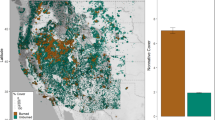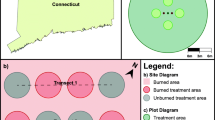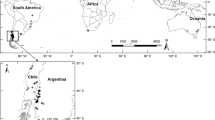Abstract
The invasive species Eupatorium adenophorum is known to influence stand structure and wildfire the hazard in forests. In the current work, we quantitatively examined fire effects in invaded and uninvaded plots in southwestern Sichuan Province, China, with five different forest sites that had different types of dominant species: Pinus yunnanensis, P. yunnanensis–Quercus spp., Keteleeria fortunei, K. fortunei–Quercus spp., and Eucalyptus robusta. We compared the fuel chemistry (moisture, ash, heat value, and ignition point) and fire severity (flame length, fire intensity) under three burning conditions between the invaded and uninvaded plots in each forest sites, and then analyzed the results using multivariate response permutation procedures (MRPP). The burning conditions included: low (fine fuel moisture of 15 % and 5 km/h windspeed), moderate (fine fuel moisture of 10 % and 15 km/h windspeed), and extreme (fine fuel moisture of 5 % and 30 km/h windspeed). With all five sites, the fire severity and fuel loads were clearly significantly higher at the invaded sites. Fire severity was also intensified in the invaded coniferous sites compared to their mixed forest sites. These results indicate that biological invasions may increase the surface fire severity, perhaps through an increase in the heat value, and fuel loads, while reducing the moisture, ash, and ignition point of the understory herbaceous.





Similar content being viewed by others
References
Alexander ME (1982) Calculating and interpreting forest fire intensities. Can J Bot 60(4):349–357
Alvarez A, Gracia M, Retana J (2012) Fuel types and crown fire potential in Pinus halepensis forests. Eur J Forest Res 131(2):463–474
Brodersen C, Lavergne S, Molofsky J (2008) Genetic variation in photosynthetic characteristics among invasive and native populations of reed canarygrass (Phalaris arundinacea). Biol Invasions 10:1317–1325
Buccellato L, Byrne MJ, Witkowski ETF (2012) Linking trait differences to community dynamics: evidence from Eupatorium adenophorum and co-occurring native species during a three-year succession. Biol Control 61(3):222–229
Byram GM (1959) Combustion of forest fuels. In: Davis KP (ed) Forest fire: control and use. McGraw-Hill, New York, pp 61–89
Cruz MG, Alexander ME, Wakimoto RH (2005) Development and testing of models for predicting crown fire rate of spread in conifer forest stands. Can J For Res 35:1626–1639
Davies KW, Svejcar TJ, Bates JD (2009) Interaction of historical and nonhistorical disturbances maintains native plant communities. Ecol Appl 19:1536–1545
Doerr SH, Shakesby RA, Walsh RPD (1998) Spatial variability of soil hydrophobicity in fire-prone eucalyptus and pine forests, portugal. Soil Sci 163(4):313–324
Editorial Board of the Flora of Sichuan (1990) The flora of Sichuan. Sichuan people’s Publishing House, 50
Fosberg MA, Deeming JE (1971) Derivation of the one-and ten-hour timelag fuel moisture calculations for fire-danger rating, vol 207. Rocky Mountain Forest and Range Experiment Station, Forest Service, US Dept. of Agriculture
Gao XM, Zhao YJ, Tang HC (2010) Phenological characteristics of invasive plant crofton weed and measures for controlling its invasion. For Pest Dis 29(1):26–30
Gao XM, Zhao YJ, Yang XJ (2013) Linking trait differences to community dynamics: evidence from Eupatorium adenophorum and co-occurring native species during a three-year succession. PLoS One 8:1
Garcia Sanchez E, Ramirez Lopez CB, del Rio Torres REN, Martinez Pacheco MM (2011) Una revisión de Eupatorium (Compositae: Eupatorieae) de Michoacán. Phyton (Buenos Aires) 80(2):139–146
Gui FR, Wan FH, Guo JY (2008) Population genetics of Ageratina adenophora using inter-simple sequence repeat (1SSa) molecular markers in China. Plant Biosyst 142(2):255–263
Gunin PD, Vostokova EA, Dorofeyuk NI, Tarasov PE, Black CC (1999) Strategies for nature management and vegetation conservation. In: Vegetation dynamics of Mongolia, Springer, Netherlands, pp 165–202
Han HJ, Zhou YW (2009) Present situations and countermeasures of “3·29” forest fires in Anning. J Anhui Agric Sci 37(34):17196–17198
Harrington MG (1982) Stand, fuel, and potential fire behavior characteristics in an irregular southeastern Arizona ponderosa pine stand. USDA Forest Service, Rocky Mountain Forest And Range Experiment Station, Research Note RM-418, Fort Collins
Holden ZA, Jolly WM (2011) Modeling topographic influences on fuel moisture and fire danger in complex terrain to improve wildland fire management decision support. For Ecol Manage 262(12):2133–2141
Huckaby LS, Moir WH (1995) Fire history of subalpine forests at Fraser Experimental Forest, Colorado. USDA For Serv Gen Tech Rep INT-310, pp 205–210
Ju R, Li H, Shi ZR, Li B (2012) Progress of biological invasions research in China over the last decade. Biodivers Sci 20(5):581–611
Jurskis V (2012) Plant invasions: symptoms and contributors rather than causes of environmental degradation. Forests 3(4):896–902
Kluge RL (1991) Biological control of crofton weed, Ageratina adenophora (Asteraceae), in South Africa. Agric Ecosyst Environ 37(3):187–191
Knowler D, Barbier E (2005) Importing exotic plants and the risk of invasion: are market-based instruments adequate? Ecol Econ 52:341–354
Kurade NP, Vikas J, Kaul VK, Sharma OP (2010) Chemical composition and antibacterial activity of essential oils of Lantana camara, Ageratum houstonianum and Eupatorium adenophorum. Pharm Biol 48(5):539–544
Li SY, Ma CL, Yuan JJ, Wang WY, Chen HG (2008) A study on ecological adaptability strategies to wildland fire of 4 exotic species in Kunming area. Acta Agriculturae Universitatis Jiangxiensis 30(2):268–274
Li D, Niu SK, Long XH, Xu GX, Wang S, Chen F (2013) Relationship of forest fires and meteorological factors in Sichuan province. J Northwest Agric For Univ 41(6): 67–74
Lu CT (2004) A study of the relations between the basal diameter and diameter at breast height of Pinus yunnanensis in Sichuan and their application. J Sichuan For Sci Technol 25(2):46–50
Menning KM, Stephens SL (2007) Fire climbing in the forest: a semiqualitative, semiquantitative approach to assessing ladder fuel hazards. West J Appl For 22(2):88–93
Mielke PW Jr (1984) 34 Meteorological applications of permutation techniques based on distance functions. Handb Stat 4:813–830
Mozdzer TJ, Zieman JC (2010) Ecophysiological differences between genetic lineages facilitate the invasion of non-native Phragmites australis in North American Atlantic coast wetlands. J Ecol 98:17–27
Niu SK (2013) Fire behavior and fuel spatial continuity of major forest types in the mountainous area. Beijing Forestry University, Beijing
Peterson DL, Johnson MC, Agee JK, Jain TB, Mckenzie D, Reinhardt ED (2005) Forest structure and fire hazard in dry forests of the western United States. US For Serv Gen Tech Rep PNW-GTR-628, 30
Pickard JM (2002) Critical ignition temperature. Thermochim Acta 392:37–40
Pollet J, Philip NO (2002) Effect of thinning and prescribed burning on crown fire severity in ponderosa pine forests. Int J Wildland Fire 11(1):1–10
Pyne SJ, Andrews PL, Laven RD (1996) Introduction to wildland fire science. Wiley, New York
Reichard SH, White P (2003) Invasion biology: an emerging field of study. Ann Mo Bot Gard 90:64–66
Rothermel RC (1972) A mathematical model for predicting fire spread in wildland fuels, p 26
Sax DF, Brown JH (2000) The paradox of invasion. Global Ecol Biogeogr 9(5):363–371
Sharma GP, Singh JS, Raghubanshi AS (2005) Plant invasions: emerging trends and future implications. Curr Sci 88(5):726–734
Srivastava R, Singh KP (2014) Diversity in weed seed production and the soil seed bank: contrasting responses between two agroecosystems. Weed Biol Manag 14(1):21–30
Tian MJ (2010) Photosynthetic ecophysiology of crofton weed during the dry season in the dry valley of Jinsha river and its invasion risks to Sichuan basin. J China West Norm Univ 31(4):364–372
Tim M, Blackburn PP, Sven B, James TC, Richard PD et al (2011) A proposed unified framework for biological invasions. Trends Ecol Evol 26(7):333–339
Tripathi RS, Yadav AS (1987) Population dynamics of Eupatorium adenophorum spreng and Eupatorium riparium Regel in relation to burning. Weed Res 27(4):229–236
Turpie JK, Heydenrych BJ, Lamberth SJ (2003) Economic value of terrestrial and marine biodiversity in the Cape Floristic region: implications for defining effective and socially optimal conservation strategies. Biol Conserv 112:233–251
Van Mantgem PJ, Schwilk DW (2009) Negligible influence of spatial autocorrelation in the assessment of fire effects in a mixed conifer forest. Fire Ecol 5(2):116–125
Van Wanger CE (1977) Conditions for the start and spread of crown fire. Can J For Res 7:23–34
Wang WQ, Wang JJ, Zhao ZM, Zhang W (2010) Effects of Eupatorium adenophorum Spreng invasion on diversity of plant community in abandoned arable land. J Huazhong Agric Univ 29(3):300–306
Wang S, Niu SK, Li D, Wang JH, Chen F, Sun W (2013) Vertical distribution characteristics of fuels in Pinus yunnanensis and its influence factors. Chin J Appl Ecol 24(2):331–337
Wang QH, Xiao HJ, Xu SJ, Tong YM, Li SY, Qian B, Yang X (2014) Combustibility of Eupatorium adenophorum in Central Yunnan Province. For Resour Manag 2:130–135
Wu ZW, He HS, Chang Y, Liu ZH, Chen HW (2011) Development of customized fire behavior fuel models for boreal forests of northeastern China. Environ Manage 48:1148–1157
Xu HG, Qiang S, Han ZM, Guo JY, Huang ZG, Sun HY, He SP, Ding H, Wu HR, Wan FH (2004) The distribution and introduction pathway of alien invasive species in China. Biodivers Sci 12(6):626–638
Yang B, Yang JZ, Pan XY, Xu HG, Li B (2010) Alien terrestrial herbs in China: diversity and ecological insights. Biodivers Sci 18:660–666
Yin F, Hu J, Zhang WD, Li JC, Xu R, Chen YB, Liu SQ (2010) The study on co-fermentation of hydrogen and methane production by Eupatorium adenophorum spreng. Chin Sci Bull 36:3469–3476
Yu XJ, Yu D, Ma KP (2004) Relationship between allelpathy and invasiveness by Eupatorium adenophorum at different sites. Ata Phytoecologica Sinica 28(6):773–780
Zheng YB, Zhang YY, Liao ZY, Li LL, Zhou JF, Wang QH, Li SY (2014) Combustion characteristics of stems and leaves of Eupatorium adenophorum. J Zhejiang Agric For Univ 31(3):450
Zhou SM, Ou GT, Li JS, Xu DQ, Cai WD, Zhao YX (2010) Study on the bio-ecological characteristics of Eupatorium adenophorum sprenge. Guizhou For Sci Technol 2:38–40
Acknowledgments
This study is part of Special Research Program for Public-welfare Forestry: Responses of forests to climate change and adaptive strategy of forestry in China, Grant No. 200804001; Thanks are due to the Headquarters of Forest Fire Prevention, Sichuan Province for useful fire data on statistical analysis. We would also like to thank the Command College of Armed Police Forces, Beijing, P. R. China for experiment.
Author information
Authors and Affiliations
Corresponding author
Ethics declarations
Conflicts of interest
The manuscript has not been previously published, is not currently submitted for review to any other journal, and will not be submitted elsewhere before a decision is made by this journal. In addition, a justification for the publication in Journal of Power Sources is enclosed.
Rights and permissions
About this article
Cite this article
Wang, S., Niu, S. Do biological invasions by Eupatorium adenophorum increase forest fire severity?. Biol Invasions 18, 717–729 (2016). https://doi.org/10.1007/s10530-015-1043-8
Received:
Accepted:
Published:
Issue Date:
DOI: https://doi.org/10.1007/s10530-015-1043-8




